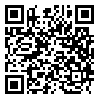Volume 9, Issue 2 (9-2022)
Human Information Interaction 2022, 9(2): 25-34 |
Back to browse issues page
Download citation:
BibTeX | RIS | EndNote | Medlars | ProCite | Reference Manager | RefWorks
Send citation to:



BibTeX | RIS | EndNote | Medlars | ProCite | Reference Manager | RefWorks
Send citation to:
sabaghinejad Z, khalaf-kabomeiri A, fakhri A. Assessing the Internal Structure of the Ellis Information Retrieval Model in Order to Present the Persian Norm of Web Retrieval Tools. Human Information Interaction 2022; 9 (2)
URL: http://hii.khu.ac.ir/article-1-3043-en.html
URL: http://hii.khu.ac.ir/article-1-3043-en.html
Department of Medical Library and Information Science, School of allied medical sciences, Ahvaz Jundishapur University of Medical Sciences, Ahvaz, Ira
Abstract: (2726 Views)
Introduction: Study evaluated the internal structure of Ellis information seeking model in the student community with the aim of presenting the Persian norm.
Methods: This is a descriptive-analytical study conducted by cross-sectional survey method in the second semester of the academic year 1399-1400. Population comprise of 280 graduate students at Ahvaz Jundishapur University of Medical Sciences. Data collection tool is a questionnaire based on Ellis information seeking behavior pattern with 41 questions. Findings were analyzed using SPSS software and Amos.
Results: Results of exploratory factor analysis by principal component method with Varimax cycle led to identify five factors of identification, confirmation and organization; Monitoring, conservation and extraction; Relevance; Availability and up-to-datedness and credit factor. The extracted five-factor pattern explains more than 66% of the changes in information seeking behavior. The results of confirmatory factor analysis indicate the optimal fit of the extracted pattern. All factors had good consistency and Cronbach's total alpha of the instrument was 0.97.
Conclusion: The five-factor pattern of web-based information retrieval behavior is a new self-report tool for assessing the nature of academic user retrieval behavior on the Web. This pattern is based on Ellis's information pattern in terms of content and items used, but it differs from it in terms of subscale.
Methods: This is a descriptive-analytical study conducted by cross-sectional survey method in the second semester of the academic year 1399-1400. Population comprise of 280 graduate students at Ahvaz Jundishapur University of Medical Sciences. Data collection tool is a questionnaire based on Ellis information seeking behavior pattern with 41 questions. Findings were analyzed using SPSS software and Amos.
Results: Results of exploratory factor analysis by principal component method with Varimax cycle led to identify five factors of identification, confirmation and organization; Monitoring, conservation and extraction; Relevance; Availability and up-to-datedness and credit factor. The extracted five-factor pattern explains more than 66% of the changes in information seeking behavior. The results of confirmatory factor analysis indicate the optimal fit of the extracted pattern. All factors had good consistency and Cronbach's total alpha of the instrument was 0.97.
Conclusion: The five-factor pattern of web-based information retrieval behavior is a new self-report tool for assessing the nature of academic user retrieval behavior on the Web. This pattern is based on Ellis's information pattern in terms of content and items used, but it differs from it in terms of subscale.
Keywords: Ellis Information Seeking Model, Standardization, Validation, Information Seeking Behavior.
References
1. Agarwal, N. K. (2017). Exploring context in infor-mation behavior: Seeker, situation, surroundings, and shared identities. Synthesis lectures on in-formation concepts, retrieval, and services, 9(7), i-163. [DOI:10.2200/S00807ED1V01Y201710ICR061]
2. Azami M, Davarpanah M. The information needs and information seeking behaviours in Iran a re-view of researches. Journal of management and medical informatics school. 3. 2013; 1(1) :65-79. http://jms.kmu.ac.ir/article-1-27-en.html
3. Case, D. O., & Given, L. M. (2016). Looking for information: A survey of research on infor-mation seeking, needs, and behavior. Emerald Group Publishing. [DOI:10.1108/S2055-53772016022]
4. Ellis, D., Cox, D., & Hall, K. (1993). A comparison of the information seeking patterns of research-ers in the physical and social sciences. Journal of documentation, 49(4), 356-369. [DOI:10.1108/eb026919]
5. Gordon, I. D., Cameron, B. D., Chaves, D., & Hutchinson, R. (2020). Information Seeking Be-haviors, Attitudes, and Choices of Academic Mathematicians. Science & Technology Librar-ies, 39(3), 253-280. https://doi:10.1080/0194262X.2020.1758284 [DOI:10.1080/0194262X.2020.1758284]
6. Kundu, D. K. (2017). Models of information seek-ing behaviour: A comparative study. Methodolo-gy, 7(4), 393-405. http://ijlis.org [DOI:10.2139/ssrn.4289303]
7. Lalazaryan, A., & Zare-Farashbandi, F.) (2014). A Review of models and theories of health infor-mation seeking behavior. International Journal of Health System and Disaster Management, 2(4), 193-203. https://doi:10.4103/2347-9019.144371 [DOI:10.4103/2347-9019.144371]
8. MacCallum, R. C., Browne, M. W., & Sugawara, H. M. (1996). Power analysis and determination of sample size for covariance structure modeling. American Psychological Association, US, 1(2), 130-149. https://doi:10.1037/1082-989X.1.2.130 [DOI:10.1037/1082-989X.1.2.130]
9. Starcevic, V., & Aboujaoude, E. (2015). Cyber-chondria, cyberbullying, cybersuicide, cybersex: "new" psychopathologies for the 21st century?. World psychiatry: official journal of the World Psychiatric Association (WPA), 14(1), 97-100. [DOI:10.1002/wps.20195] [PMID] []
10. Bigdeli Z, Pourmosavi Z. A survey of Everyday -Life Information Seeking (ELIS) and Infor-mation Grounds of Armenians in Tehran. Hu-man Information Interaction. 2018; 4 (4). [InPersian]
11. URL: http://hii.khu.ac.ir/article-1-2495-en.html
12. Jalali Dizaji A, Parvini Z. Appropriate Information Seeking Behavior in Web for Higher Education Students of Razi University. Research on Infor-mation Science & Public Libraries. 2011; 17 (3):403-426. [InPersian]. URL: http://publij.ir/article-1-121-en.html
13. Shafiee S, Alishan Karami N, Tahamtan I, Radad I. Web Information Seeking Behavior of Post-graduate Students at Hormozgan University of Medical Sciences based on Ellis' Model. JMIS. 2016;2 (2) :1-9. [InPersian]. URL: http://jmis.hums.ac.ir/article-1-73-fa.htm
14. Norouzi Y, Sokhanvari N. A Study of compatibility between Iranian digital libraries user interface and the elements of Ellis model of information seeking behavior. Iranian Journal of information processing and management. 2014; 29 (4) :949-978.[InPersian]. URL: http://jipm.irandoc.ac.ir/article-1-2445-fa.html
Send email to the article author
| Rights and permissions | |
 | This work is licensed under a Creative Commons Attribution-NonCommercial 4.0 International License. |






